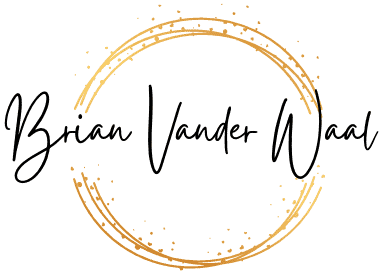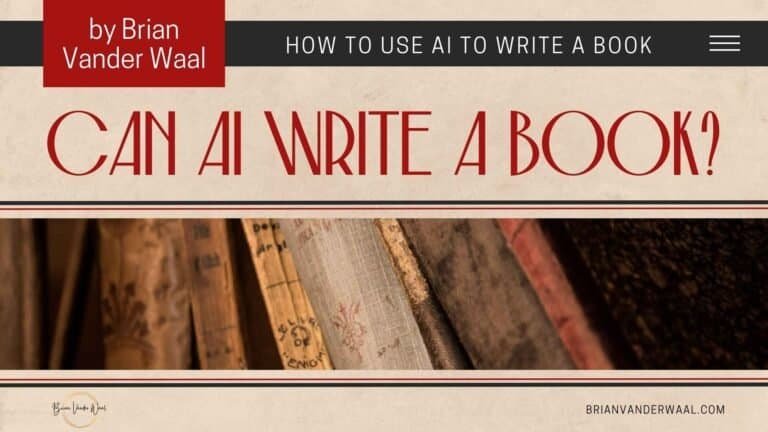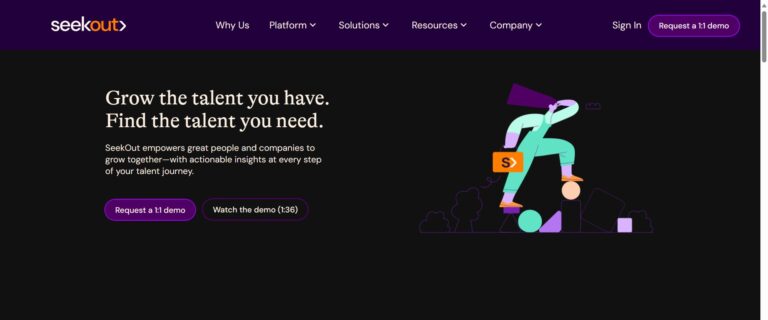Ever feel like you’re drowning in data at work? Spreadsheets pile up, reports never seem to end, and crucial insights get lost in the chaos. This information overload can leave you feeling frustrated and stuck. AI-human collaboration in the workplace can help!
AI can analyse your data in seconds, find hidden patterns, and spit out clear answers. That’s the magic of AI, and it’s here to transform how we work, not replace us!
Imagine a doctor who can use AI to analyse mountains of patient data, identifying potential risks and personalising treatment plans. Or a financial advisor who can leverage AI to uncover hidden investment opportunities and make data-driven recommendations for their clients. These are just a few examples of the powerful partnership between AI and human expertise.
This guide will explore the transformative nature of AI-human collaboration, showing you how AI can become your ultimate work partner. I will discuss the benefits of this potent team, explore real-world examples, and even address some of the challenges and future considerations.
Key Takeaways
- Trust Barriers Kill More AI Projects Than Technical Issues: Building trust requires demonstrating value through small wins, not explaining features. Start with low-risk, high-impact applications.
- AI-Human Teams Deliver 40% Higher Productivity: Companies see dramatic gains when humans focus on strategy and creativity while AI handles data analysis and routine tasks.
- Every Business Follows the Same AI Resistance Pattern: Denial (“We don’t need AI”) → Anger (“This doesn’t work”) → Bargaining (“Maybe for simple tasks”) → Acceptance (“How did we manage without this?”)
- Communication Training Makes or Breaks AI Success: Teaching staff to ask specific, structured questions transforms AI tools from “useless” to indispensable. Vague questions get confusing responses.
- Real-World Impact Across Industries: Social workers save 44% on paperwork time, legal document reviews are 70% faster, and manufacturing accidents dropped 35% with AI-human partnerships.
- Human Creativity Becomes More Valuable, Not Less: AI handles research and data crunching, freeing humans to focus on strategic thinking, relationship building, and creative problem-solving.
- Cross-Training Teams Prevents AI Implementation Failures: When multiple team members understand AI tools, businesses avoid workflow disruptions and maintain continuity during transitions.
Table of Contents
Understanding AI-Human Collaboration in the Workplace
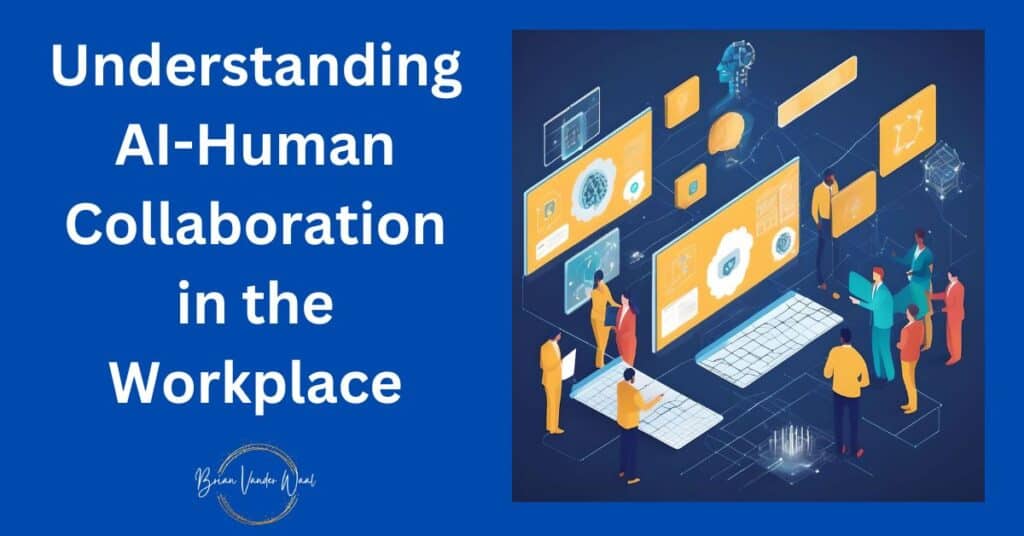
What is the Role of Artificial Intelligence in Human-AI Collaboration
Artificial Intelligence (AI) is vital in human-AI teamwork because it gives us advanced tools and algorithms. These tools help us look at and understand data in ways we couldn’t before.
For example, I used AI to analyse the interests and feedback of my customers. I discovered patterns I never noticed before, which helped me improve my services.
This teamwork ensures that AI solutions are made with human guidance, reducing mistakes and making the team more effective.
What are the Benefits of Combining Human Skills with AI
Organisations can make better decisions, increase productivity, and create new ideas when combining human skills with AI technology. For example, using Artificial Intelligence to sort through data at my client’s company helped them find new business opportunities faster.
This partnership lets businesses use data insights effectively while ensuring AI helps human workers rather than replacing them.
Why AI-Human Collaboration in the Workplace Produces the Best Results?
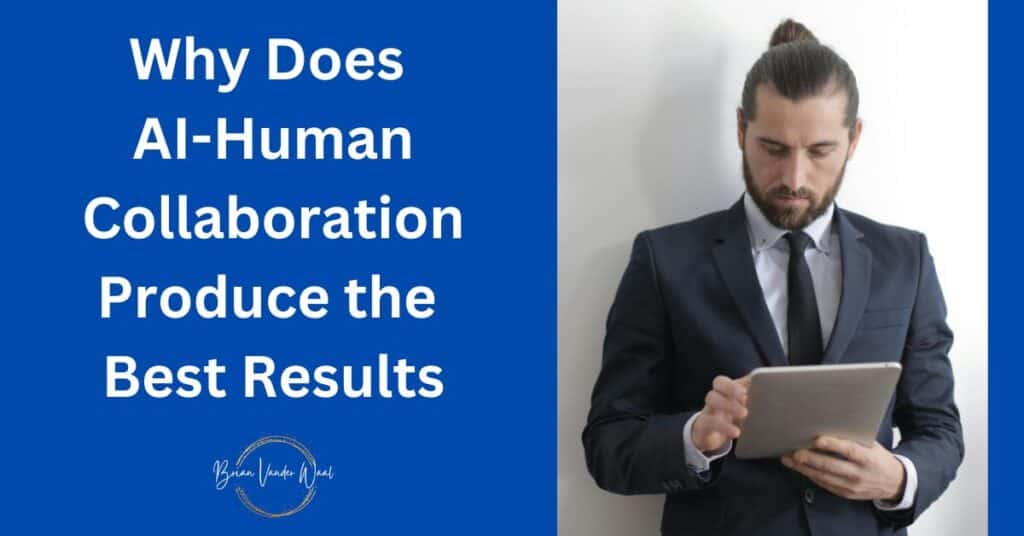
A few weeks ago, I spoke with a senior manager who was feeling overwhelmed. Her team was drowning in admin work, struggling to keep up with data analysis, and falling behind on innovation. “We’re working harder than ever,” she said, “but it feels like we’re just treading water.”
Many professionals face the same challenge: having too much to do and not enough time to think. But here’s the good news: there’s a smarter way forward.
According to recent research, companies that embrace AI-human collaboration experience productivity gains of up to 40%, faster decision-making, and lower staff burnout (Source: Mark Kelly AI).
But here’s the catch: AI doesn’t work best on its own. And neither do we.
I’ll break down five clear reasons why AI-human collaboration produces better results, with real-world examples and data to back it up.
1. Humans and AI Are Better Together
Humans and AI each offer unique strengths. While AI is great at crunching numbers, spotting trends, and managing repetitive tasks with speed and precision, people bring creativity, empathy, and the ability to navigate complex decisions. When these strengths are combined, the outcome is often greater than what either could accomplish individually.
You can think of AI as the engine powering the system and humans as the ones steering the wheel. The engine gives you speed and power, but it’s the driver who knows where to go and how to get there.
2. AI-Human Collaboration Boosts Productivity and Focus With Less Stress
One of the most significant advantages of working with AI is the considerable amount of time it saves. When AI handles routine tasks like sorting emails, analysing spreadsheets, or booking meetings, people can focus on the work that matters most.
There are many great examples of how AI has boosted productivity in various sectors. Some examples include:
- Social workers at Ealing Council now spend 44% less time on paperwork, thanks to an AI system, which gives them time back to focus on direct client support (Around Ealing).
- In the legal sector, AI has helped speed up document reviews by 70% and cut legal research time by 30%.
- In healthcare, AI-assisted diagnoses are 30% more accurate when combined with human expertise.
- In manufacturing, AI-powered robots working alongside people have helped cut production time by 50% and reduced workplace accidents by 35% (Source: Mark Kelly AI).
3. AI-Human Collaboration Leads to Smarter Decisions, Made Faster
AI can process vast amounts of data in seconds. But it’s people who ask the right questions and make the final call. When AI provides insights, we use our judgment and experience to make better decisions.
Take healthcare, for example. Radiologists now use AI tools to scan X-rays, MRIs, and CT scans. These systems can detect signs of disease that the human eye might miss.
Here’s the thing, though: doctors are still calling the shots. Sure, the AI can spot a shadow on a lung scan that might be missed, but it’s the doctor who looks at that patient sitting in front of them, knows their history, and decides what it means. The AI doesn’t know that this person’s been coughing for weeks or that their grandmother had lung cancer.
4. AI-Human Collaboration Facilitates More Innovation With Less Burnout
When repetitive tasks don’t bog people down, they have more time and energy to think creatively and focus on other initiatives. This leads to better ideas, more innovative solutions, and more engaged teams.
Companies using AI to support their staff have reported lower burnout and higher job satisfaction. AI doesn’t replace us. Instead, it empowers us. It gives us the tools to do more, think bigger, and work smarter.
5. AI-Human Collaboration Supports Better Inclusion and Accessibility
AI can also make work more inclusive. Tools like live transcription support people with hearing difficulties, and translation software helps teams across different countries work together more easily.
When more people can contribute, teams benefit from a broader range of ideas and experiences. That diversity often leads to better outcomes.
What are Some Real-Life Examples of AI-Human Collaboration in the Workplace
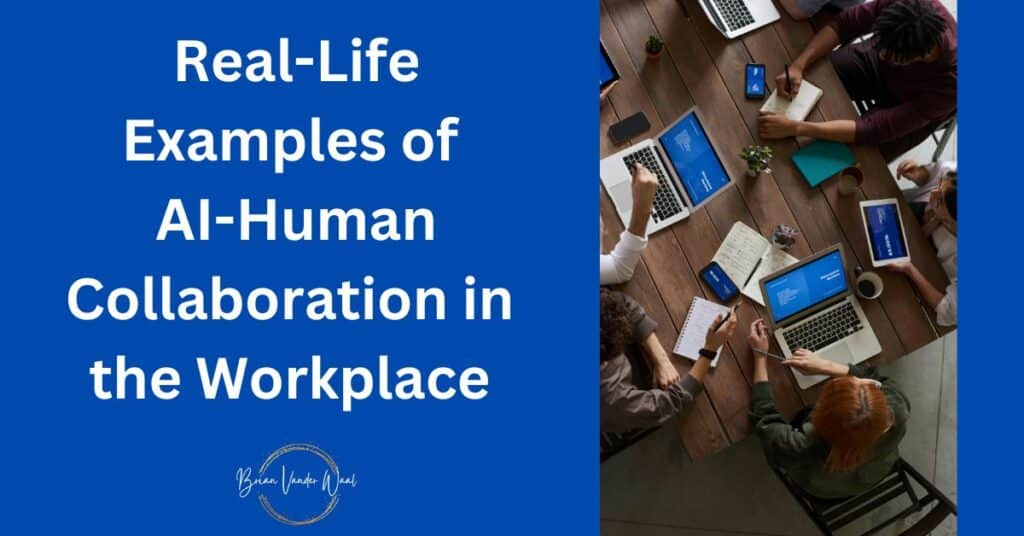
If you are in doubt about whether AI can be a powerful partner in the workplace, here are some fantastic examples of this dream team in action:
Healthcare: Saving Lives with AI Supporting Nurses
AI can monitor hundreds of patients at once, looking for even the tiniest changes in their vital signs. AI systems can analyse patient data and alert nurses to potential problems early on, giving them precious time to intervene. It’s like having an extra pair of eyes (and super-fast analysis skills) to watch over patients.
AI helpers can also remind nurses about medications, support them with paperwork and handle routine tasks.
Legal: AI Helping Lawyers to Analyse Evidence and Case Documents
Legal teams use AI to analyse mountains of case documents, identify key evidence, and predict the outcome of cases with surprising accuracy. Lawyers can then focus on their best skills, arguing cases and building relationships with clients.
Recruitment: AI is Supporting Recruiters to Source Top Talent
Recruiters often have a mountain of resumes to sort through. Finding the perfect candidate can be incredibly difficult. But that’s where AI recruitment tools come in. These AI helpers can scan through applications in seconds, finding people with the necessary skills and experience. No more endless resume piles!
Plus, AI can help eliminate bias in the hiring process, ensuring the best person gets the job, regardless of their background. When recruiters collaborate with AI, they can focus on what they do best: talking to outstanding candidates and making great hiring decisions.
Public Safety: AI is Helping Keep Firefighters Safe
Being a firefighter is a dangerous job. But AI is helping keep firefighters safe. AI drones can fly into burning buildings to locate people trapped inside and find the safest routes for firefighters. These AI partners help save lives and protect our communities.
Law Enforcement: AI is Supporting Detectives to Crack the Toughest Cases
Police work is challenging, and sometimes even the best detectives need a little help. Special AI programs can analyse massive amounts of data, like witness reports and security footage, to help identify suspects and crack cold cases.
Urban Planning: Building Sustainable Cities for the Future with AI
Architects and Urban Planners are using AI to design cities that use less energy and are friendlier to the environment. They use AI to analyse traffic patterns, sunlight exposure, energy consumption, and more. As a result, they can design cities that are beautiful and sustainable for the future. Pretty cool, right?
Agriculture: AI is Helping Farmers Grow Food for the Future
Our world’s population is growing, and we must find more innovative ways to grow food. AI helps farmers analyse things like soil conditions and weather patterns. As a result, they can plant suitable crops in the right places and use water more efficiently. AI can help us grow more food with fewer resources.
Design: AI Supporting Fashion Designers With Fashion Forecasting
Ever wonder how fashion designers know what clothes will be hot next season? AI can help! Fashion companies are partnering with AI to analyse social media trends, weather patterns, and celebrity styles. This AI “stylist” helps designers create clothes people will love, making the fashion world a more data-driven place.
Archaeology: AI Supporting Archaeologists to Uncover Hidden Treasures
Archaeologists use AI to analyse satellite images and ground surveys to identify potential archaeological sites. As a result, they can focus their digging efforts on the most promising areas, saving them time and resources. Who knows, maybe AI will help us find the lost city of Atlantis!
Sport: AI Coaches Creating Champion Athletes
Have you ever dreamed of being an Olympic athlete? AI can help! Special AI coaches can analyse athletes’ movements, identify weaknesses, and suggest training improvements. It’s like having a super-smart coach who can watch every move you make and give you personalised feedback. With this AI help, athletes can train smarter, not just harder, and reach their full potential.
How to Overcome Barriers to Effective AI-Human Collaboration in the Workplace
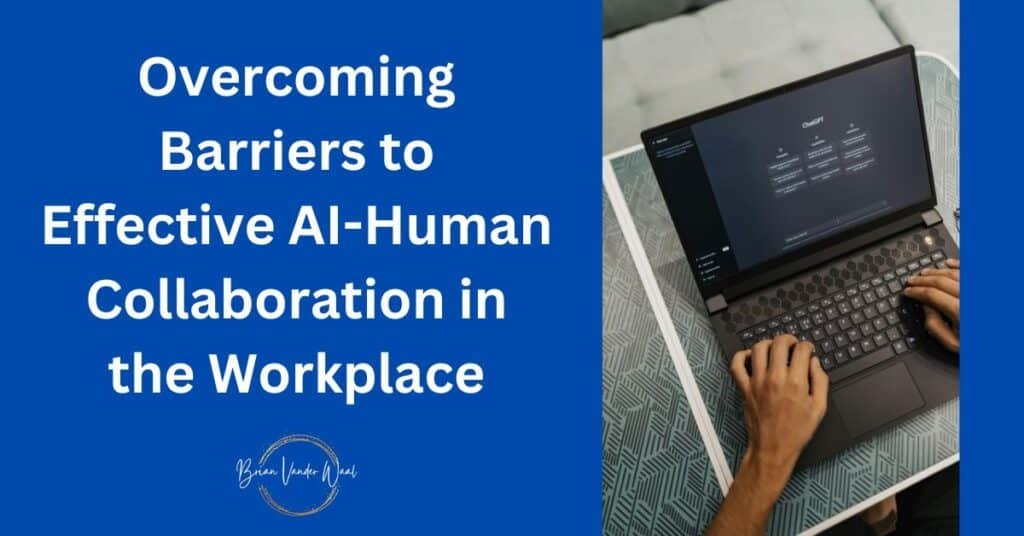
Getting humans and AI to work together smoothly? It’s trickier than you’d think. Moreover, the most significant obstacles aren’t technical but rather human.
I’ve repeatedly seen the same barriers after advising dozens of businesses on AI implementation. Trust issues, communication breakdowns, and fear of the unknown derail more AI projects than software bugs ever could.
However, these challenges aren’t insurmountable. Furthermore, understanding why they happen helps you navigate them successfully. Let me share what I’ve learned from successful implementations and spectacular failures.
The Trust Barrier Nearly Killed One Client’s AI Project
When I started advising small businesses on AI implementation, trust issues caught me entirely off guard. However, my work with one client showed me how deep these concerns run.
A local marketing agency reached out to me for advice after their staff revolted against new AI writing tools. The creative team felt threatened, convinced AI would steal their jobs. Meanwhile, management wondered why expensive software sat unused.
I realised that building trust requires demonstrating value, not just explaining features. Therefore, I helped them start with simple tasks where AI clearly assisted rather than replaced human creativity.
Transparency is Central to Successful AI Implementation
One small business owner confided his biggest fear: “What if my AI tool makes decisions I can’t explain to customers?” At that moment, I realised that transparency is central to successful implementation.
I help clients understand exactly what their AI tools do and don’t do. For instance, when a recruitment firm uses AI screening, I ensure they can explain the criteria to candidates. Additionally, we establish clear guidelines for when humans override AI decisions.
This openness builds confidence internally and externally. Moreover, it helps businesses use AI ethically and responsibly.
Communication Training Changed Everything
Most businesses assume AI communication will be intuitive, but that’s rarely true. However, proper training transforms AI from frustrating to fantastic.
I watched a small accounting firm struggle with its AI expense tool. Staff would ask vague questions and get confusing responses. Subsequently, they declared the system “useless” and returned to manual processes.
The same AI tool became incredibly helpful after teaching them to ask specific, structured questions. Furthermore, we customised response templates to match their business terminology.
The Resistance Pattern I See Everywhere
Every business I advise follows a predictable pattern of AI resistance. Therefore, I’ve developed strategies to navigate these stages effectively.
First comes denial: “We don’t need AI.” Then anger: “This thing doesn’t work properly.” Next, bargaining: “Maybe for simple tasks only.” Eventually, acceptance: “How did we manage without this?”
Understanding this progression helps me guide businesses through the transition more smoothly. Further, sharing stories from successful implementations builds confidence during difficult phases.
Small Wins Build Big Confidence
I always recommend starting with low-risk, high-impact AI applications. Early successes create momentum for broader adoption.
One retail client began using AI for inventory forecasting. When it accurately predicted seasonal demand patterns, staff trust increased dramatically. Subsequently, they expanded AI use to customer service and marketing.
These success stories become powerful tools for overcoming resistance in other areas. Furthermore, they demonstrate tangible business value rather than theoretical benefits.
How Is AI Changing the Human Side of Work?
AI and machine learning are developing quickly, changing how people and AI work together. Advances in AI tools and techniques make it easier to interact with AI in more sophisticated ways.
As AI continues to develop, working with it becomes increasingly complex. It’s important to understand these changes to adjust how we use AI and get the best results from people and machines working together as a team.
People Must Learn Faster to Keep Up With AI
One of the most noticeable shifts has been the rapid need for people to learn and adapt to new tools.
Machine learning development has completely transformed my consulting practice. What I recommended six months ago might be outdated today.
When I started advising businesses on AI, basic chatbots required extensive programming and training. However, modern AI tools understand context and nuance with minimal setup. As a result, implementation timelines have shortened dramatically.
This rapid evolution means I must constantly update my knowledge and approaches. Similarly, businesses must also keep pace with emerging opportunities and developments. This is something many companies struggle with. This is why continuing professional development (CPD) is essential for business leaders and employees.
Business Leader’s Expectations are Skyrocketing
Alongside technical changes, I’ve seen a dramatic shift in how people expect AI to work.
Advanced AI capabilities have sparked a wave of unrealistic expectations among business leaders. Managing these expectations is now crucial to the success of any implementation.
For example, a restaurant owner recently asked (only half-seriously) if AI could “read customers’ minds and predict exactly what they’ll order.” We both laughed. However, I used the opportunity to explain current limitations while highlighting real, practical opportunities.
These inflated expectations are often fueled by impressive AI demos in the media and hype-driven marketing. At the same time, many businesses underestimate the human expertise required to make AI truly effective.
AI Implementation is Highlighting the Human Side of Change
Another significant development is the impact of AI tools on internal dynamics and team workflows.
As AI becomes more advanced, teamwork often becomes more complicated. That’s why effective change management strategies are crucial.
A law firm I advised implemented advanced AI for document analysis. The system delivered impressive results but required extensive training for proper use. Subsequently, some staff members became power users, while others fell behind.
This capability gap created internal tensions and workflow disruptions. Furthermore, it highlighted the need for comprehensive training programmes rather than simple software installation.
Human Creativity is Becoming More Valuable, Not Less
One of the most encouraging trends is that AI hasn’t replaced human creativity. Instead, it’s made it more essential.
Even though AI is becoming increasingly intelligent, people remain crucial when a business needs to make strategic decisions. However, the ways people help are changing in meaningful ways.
In my work, AI handles simple research tasks, allowing me to focus on sharing my ideas and real-life experiences. As a result, my content feels more original and less like everyone else’s.
Companies that utilise this type of teamwork often experience a significant increase in productivity. Additionally, employees are generally happier when they are not required to repeatedly perform the same tedious tasks, allowing them to focus on being more creative and solving interesting problems instead.
Successful Teams are Treating AI as an Ongoing Journey
Businesses need to think long-term and be flexible to truly benefit from AI’s development.
The most successful businesses have a clear plan for using AI. I help my clients build simple, long-term strategies and frameworks they can use.
Regular check-ins help identify new ways to utilise AI and highlight what is no longer effective.
It also helps when multiple team members are familiar with the tools. This is why training the whole team or several team members (i.e. cross-training) is so important. That way, things don’t fall apart if one person is away.
The best results come from treating AI as a journey, not a one-time setup. These teams also allocate funds in their budgets for ongoing learning and system updates.
AI and Human Synergy: A New Chapter
The synergy between AI and human skills marks a new chapter in approaching and executing work. Collaborative intelligence, which combines human abilities with AI technologies, creates new possibilities. As AI evolves, the relationship between humans and machines becomes more symbiotic, with each complementing the other’s strengths.
Anticipated Trends in Collaborative Intelligence
Collaborative intelligence is the potent mix of AI algorithms and human workers working well together. This teamwork boosts human abilities.
Looking ahead, the future of collaborative intelligence holds exciting possibilities, with trends such as enhanced personalisation, improved decision-making, and AI integration across tasks.
For example, businesses might see AI helping more with personalised customer service, improving client interactions. Adopting these trends will be crucial for unlocking the full potential of collaborative intelligence in the workplace.
Conclusion: AI-human Collaboration in the Workplace
This guide has shown you how Artificial Intelligence tools and systems can be your ultimate work partner in the age of AI. This partnership can boost productivity, improve decision-making, ignite creativity, and lead to innovative solutions. But the journey continues. The future of AI-human collaboration in the workplace is brimming with possibilities!
Are you ready to be a part of it?
Here are your next steps:
- Upskill Yourself: The future workforce thrives on human-AI partnerships. Explore online courses or workshops to learn the basics of AI and how it can complement your skill set.
- Embrace New Tools: Experiment with AI-powered tools designed for your industry. From data analysis to content creation, an AI assistant is waiting to lighten your load. Leaders specifically must understand how AI is redefining leadership and management to guide these collaborations effectively.
- Become an Advocate: Share your knowledge and excitement about AI-human collaboration with colleagues and management. The more we understand this powerful partnership, the better equipped we are to leverage its potential.
AI offers a massive opportunity to boost your productivity and solve problems faster than ever before. But technology is only as good as the person using it. Make AI your partner, and you will find yourself achieving far more in the workplace than you ever thought possible.
